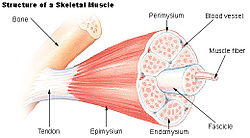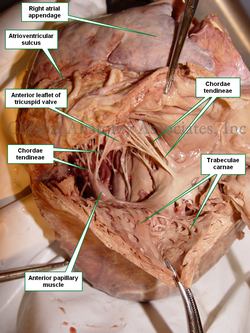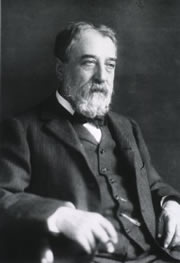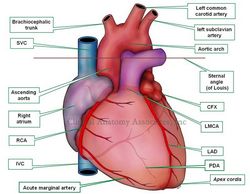
Medical Terminology Daily (MTD) is a blog sponsored by Clinical Anatomy Associates, Inc. as a service to the medical community. We post anatomical, medical or surgical terms, their meaning and usage, as well as biographical notes on anatomists, surgeons, and researchers through the ages. Be warned that some of the images used depict human anatomical specimens.
You are welcome to submit questions and suggestions using our "Contact Us" form. The information on this blog follows the terms on our "Privacy and Security Statement" and cannot be construed as medical guidance or instructions for treatment.
We have 871 guests online

Georg Eduard Von Rindfleisch
(1836 – 1908)
German pathologist and histologist of Bavarian nobility ancestry. Rindfleisch studied medicine in Würzburg, Berlin, and Heidelberg, earning his MD in 1859 with the thesis “De Vasorum Genesi” (on the generation of vessels) under the tutelage of Rudolf Virchow (1821 - 1902). He then continued as a assistant to Virchow in a newly founded institute in Berlin. He then moved to Breslau in 1861 as an assistant to Rudolf Heidenhain (1834–1897), becoming a professor of pathological anatomy. In 1865 he became full professor in Bonn and in 1874 in Würzburg, where a new pathological institute was built according to his design (completed in 1878), where he worked until his retirement in 1906.
He was the first to describe the inflammatory background of multiple sclerosis in 1863, when he noted that demyelinated lesions have in their center small vessels that are surrounded by a leukocyte inflammatory infiltrate.
After extensive investigations, he suspected an infectious origin of tuberculosis - even before Robert Koch's detection of the tuberculosis bacillus in 1892. Rindfleisch 's special achievement is the description of the morphologically conspicuous macrophages in typhoid inflammation. His distinction between myocardial infarction and myocarditis in 1890 is also of lasting importance.
Associated eponyms
"Rindfleisch's folds": Usually a single semilunar fold of the serous surface of the pericardium around the origin of the aorta. Also known as the plica semilunaris aortæ.
"Rindfleisch's cells": Historical (and obsolete) name for eosinophilic leukocytes.
Personal note: G. Rindfleisch’s book “Traité D' Histologie Pathologique” 2nd edition (1873) is now part of my library. This book was translated from German to French by Dr. Frédéric Gross (1844-1927) , Associate Professor of the Medicine Faculty in Nancy, France. The book is dedicated to Dr. Theodore Billroth (1829-1894), an important surgeon whose pioneering work on subtotal gastrectomies paved the way for today’s robotic bariatric surgery. Dr. Miranda.
Sources:
1. "Stedmans Medical Eponyms" Forbis, P.; Bartolucci, SL; 1998 Williams and Wilkins
2. "Rindfleisch, Georg Eduard von (bayerischer Adel?)" Deutsche Biographie
3. "The pathology of multiple sclerosis and its evolution" Lassmann H. (1999) Philos Trans R Soc Lond B Biol Sci. 354 (1390): 1635–40.
4. “Traité D' Histologie Pathologique” G.E.
Rindfleisch 2nd Ed (1873) Ballieres et Fils. Paris, Translated by F Gross
"Clinical Anatomy Associates, Inc., and the contributors of "Medical Terminology Daily" wish to thank all individuals who donate their bodies and tissues for the advancement of education and research”.
Click here for more information
- Details
This article is part of the series "A Moment in History" where we honor those who have contributed to the growth of medical knowledge in the areas of anatomy, medicine, surgery, and medical research.
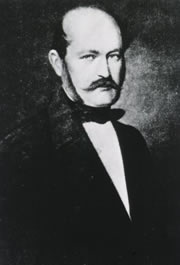
Ignaz Semmelweis
Ignaz Semmelweis, MD (1818- 1865). Born in Budapest as Ign?c F?l?p Semmelweis, he started his university studies as a lawyer, but changed to Medicine and in 1844, at the age of 26, attained his MD degree. in 1847 he was appointed as an assistant in Obstetrics, almost at the same time of the death of a friend (Kolletschka, a pathologist) who died of what appeared to be "puerperal fever", also known as "childbed fever" after being accidentally stabbed by a knife during the autopsy of a female who had died of that disease. Semmelweis reasoned that the disease somehow was transmitted via the wound and started a crusade to have surgeons and students clean their hands with a carbolized solution before examining a healthy pregnant woman.
Although the obstetric wards under his care reduced the rate of this disease to almost nothing, Semmelweis endured criticism from his teachers, colleagues, and peers, and he did not make any friends by calling "murderers" those who did not follow his ideas. murderers". An excerpt of a letter to one of this detractors reads: "I denounce you before God and the world as a murderer and the history of puerperal fever will not do you an injustice when for the service of having been the first to oppose my life-saving technique it perpetuates your name as a medical Nero". He did not publish his findings until later in life, and then received even more criticism.
In 1865 was committed to an mental asylum only to die a few days later. He was only 47 years old. The same year he died Joseph Lister performed the first operations using antiseptic technique.
Sources:
1. Newsom S." Pioneers in Infection Control - Semmelweis, Ignaz Philipp". The Journal of hospital infection. 1993-03-01;23:175-187.
2. Ellis, H. (2008). Ignaz Semmelweis: tragic pioneer in the prevention of puerperal sepsis. British Journal Of Hospital Medicine (London, England: 2005), 69(6), 358
3. " A Corner of History: Ignaz Philipp Semmelweis" Wynder, EL Prev Med 3" (4) Dec 1974, 574-580
4. "Ignaz Semmelweis; a hand-washing pioneer" P. Rangapa JAPI May 2010 58:328
Original image courtesy of Images from the History of Medicine
- Details
The term [muscle] arises from the Latin word [musculus] which derives from the Latin term [mus] meaning "mouse". We can only guess that, just as today, Roman fathers would show their biceps and forearm muscles to their children and tried to make them believe a mouse had gotten under their skin!. The root term for muscle is [-my-]. The corresponding combining form is [-myo-].
There are three types of muscle in the human body:
- Skeletal muscle: it is typical of muscles related to bones (skeletal) and they are voluntary.
- Smooth muscle: found in organs that act without volition (involuntary), such as the digestive system and glands.
- Cardiac muscle: found exclusively in the heart.
Skeletal and cardiac muscles have distinct striations visible under a microscope.
Muscles are formed by subunits, each one surrounded by a named membrane. One of the suffixes that means layer or membrane is [-sium]:
- Epimysium: Epi=outer; my=muscle; sium=membrane. The outer or external membrane (layer) of a muscle
- Perimysium: Peri=around; my=muscle; sium=membrane. A membrane around a muscle
- Endomysium: Endo= inner or internal; my=muscle; sium=membrane. The inner or internal membrane of a muscle-
Original image courtesy of Wikipedia. Click on the image for a larger version.
- Details
The trabeculae carnae is a meshwork of fleshy cords found in the inner aspect of the right and left ventricles of the heart.
The Latin term [trab] means "beam", and [trabeculum] refers to the group of beams that supports a roof, like an intertwined network. The plural for of [trabeculum] is [trabeculae].
The second term [carnae] is Latin for "meaty". The meaning of [trabeculae carnae] is the "meaty meshwork".
The trabeculae carnae are more evident and larger in the left ventricle than in the right ventricle, and larger and more complex towards the cardiac apex. The accompanying image shows the dissection of a human heart exposing the trabeculae carnae in the right ventricle.
Click on the image for a larger version
Image property of: CAA, Inc. Photographer: David M. Klein
- Details
Although not a medical root term, the root [-nym-] arises from the Greek [onoma] meaning "name". There are many terms that incorporate this root:
- Eponym: Use of a proper name to denote a structure
- Eunym: [Eu-] is a prefix that means "good", so it imeans a "good name". Also written as "euonym"
- Homonym: Same name
- Synomym: "A name with the same sense, or same meaning"
- Antomym: From the Greek [ant- and anti] meaning opposite. An opposite name
- Anonym: From the Greek [an- and ano-] meaning "without". Without a name (anonymous)
- Pseudonym: From the Greek [Pseudo-] meaning "false". A false name
- Toponym: From [topos], meaning place. The name of a place or location
- Details
This article is part of the series "A Moment in History" where we honor those who have contributed to the growth of medical knowledge in the areas of anatomy, medicine, surgery, and medical research.
Henry Koplik, MD (1858 -1927). American pediatrician and researcher, was born in 1858 in the city of New York. He received his MD from the College of Physicians and Surgeons at the Colombia University in New York. He spent several years studying in Berlin, Vienna, and Prague. Upon his return to the US he worked at the lower Manhattan Good Samaritan dispensary, where he later built a large pediatric outpatient clinic which became a model for the care of infants and children. In fact, under Dr Koplik's direction, this clinic became the world's first "milk depot" providing fresh milk and infant food for underprivileged mothers in the area. Dr. Koplik was one of the founders of the American Pediatric Society, and was one of its presidents.
Mostly remembered by the pathognomonic and eponymic "Koplik's spots", Dr Koplik had many other achievements. Some of them include the prophylaxis of a milk depot, the strict discipline in diagnosis and care of the pediatric patient, the discovery of the bacillus responsible for whooping cough, the prevention of cross-contamination at a pediatric ward, etc.
Dr. Koplik wrote a number of clinical and research papers on hygiene and public health, as well on a number of medical topics, plus a book on "Diseases of Infancy and Childhood".
Sources:
1. "Koplik's Spots for the Record: an Illustrated Historical Note" Brem, J; Clin Ped 1972 11:3 161-163
2. "Pediatric Profiles: Henry Koplik (1858-1927)" Bass, MH J Ped 1957 119-125
3. "The History of the First Milk Depot or Gouttes de Lait With Consultations in America" JAMA 50: 1574, 1914.
4. "Some Pediatric Eponyms: Koplik's Spots," W. R. Bett Brit. J. Child.Dis. 28: 127, 1931
Original image in the public domain, courtesy of the National Institutes of Health.
- Details
The aortic arch is a segment of the aorta that arches from the midline towards posterior and to the left. It presents with three branches. From proximal to distal they are the brachiocephalic trunk, the left common carotid artery, and the left subclavian artery. There are several anatomical variations of the branches of the aortic arch.
There is no clear anatomical landmark to denote the ending of the ascending aorta and the beginning of the aortic arch, as there is no clear anatomical landmark to denote the ending of the aortic arch and the beginning of the descending aorta. Anatomists use as a reference a horizontal plane that passes through the angle of Louis. Since this plane also separates the inferior from the superior mediastinum, the aortic arch is found in the superior mediastinum, while the ascending and descending aorta are found in the inferior mediastinum.
The aortic arch has anatomical relations with the bifurcation of the trachea, the pulmonary trunk and its bifurcation, and the left brachiocephalic vein. In its inferior surface, the aortic arch in the adult has the embryological remnant of the ductus arteriousus, called the ligamentum arteriosum.
The term "aortic arch" was coined and first used by Lorenz Heister (1683 1785)
Image property of: CAA.Inc.. Artist: Victoria G. Ratcliffe


